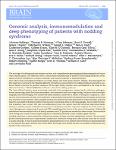| dc.description.abstract | https://doi.org/10.1093/brain/awac357 BRAIN 2023: 146; 968–976 | 968
Genomic analysis, immunomodulation and
deep phenotyping of patients with nodding
syndrome
Ariane Soldatos,1 Thomas B. Nutman, 1 Tory Johnson,1 Scott F. Dowell,2
James J. Sejvar, 2 Michael R. Wilson,3,4 Joseph L. DeRisi, 3,5 Sara K. Inati, 1
Catherine Groden, 1 Colleen Evans, 1 Elise M. O’Connell, 1 Bernard Opar Toliva, 6
Jane R. Aceng,6 Josephine Aryek-Kwe, 6 Camilo Toro, 1 Constantine A. Stratakis, 1
A. Gretchen Buckler, 1 Cathy Cantilena,1 Tara N. Palmore,1 Audrey Thurm, 1
Eva H. Baker, 1 Richard Chang, 1 Harper Fauni, 1 David Adams, 1 Ellen F. Macnamara, 1
C. Christopher Lau, 1 May Christine V. Malicdan,1 Barbara Pusey-Swerdzewski, 1
Robert Downing,7 Sudhir Bunga,2 Jerry D. Thomas, 8 William A. Gahl1
and Avindra Nath 1
The aetiology of nodding syndrome remains unclear, and comprehensive genotyping and phenotyping data from pa-
tients remain sparse. Our objectives were to characterize the phenotype of patients with nodding syndrome, inves-
tigate potential contributors to disease aetiology, and evaluate response to immunotherapy.
This cohort study investigated members of a single-family unit from Lamwo District, Uganda. The participants for
this study were selected by the Ugandan Ministry of Health as representative for nodding syndrome and with a con-
ducive family structure for genomic analyses. Of the eight family members who participated in the study at the
National Institutes of Health (NIH) Clinical Center, three had nodding syndrome.
The three affected patients were extensively evaluated with metagenomic sequencing for infectious pathogens,
exome sequencing, spinal fluid immune analyses, neurometabolic and toxicology testing, continuous electroenceph-
alography and neuroimaging. Five unaffected family members underwent a subset of testing for comparison. A dis-
tinctive interictal pattern of sleep-activated bursts of generalized and multifocal epileptiform discharges and slowing
was observed in two patients. Brain imaging showed two patients had mild generalized cerebral atrophy, and both
patients and unaffected family members had excessive metal deposition in the basal ganglia. Trace metal biochem-
ical evaluation was normal. CSF was non-inflammatory and one patient had CSF-restricted oligoclonal bands.
Onchocerca volvulus-specific antibodies were present in all patients and skin snips were negative for active onchocer-
ciasis. Metagenomic sequencing of serum and CSF revealed hepatitis B virus in the serum of one patient. Vitamin B6
metabolites were borderline low in all family members and CSF pyridoxine metabolites were normal. Mitochondrial
DNA testing was normal. Exome sequencing did not identify potentially causal candidate gene variants.
Nodding syndrome is characterized by a distinctive pattern of sleep-activated epileptiform activity. The associated
growth stunting may be due to hypothalamic dysfunction. Extensive testing years after disease onset did not clarify
a causal aetiology. A trial of immunomodulation (plasmapheresis in two patients and intravenous immunoglobulin
in one patient) was given without short-term effect, but longer-term follow-up was not possible to fully assess any
benefit of this intervention. | en_US |

